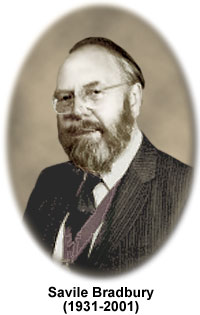Savile Bradbury
(1931-2001)

Savile Bradbury was a renowned professor of anatomy and expert in both optical and electron microscopy. He was born in Halifax, England on February 6, 1931 but moved with his family to the town of Derby at the beginning of World War II. There he attended grammar school before being awarded a state scholarship to the University of Oxford. However, he decided to fulfill his duty of National Service before continuing his education. An accomplished flutist, Bradbury joined the Royal Air Force and became a member of the Central Band, which provided him with the opportunity to travel extensively during his two-year service.
His military obligation complete, in 1951 Bradbury began coursework at Oxford's Brasenose College, where he focused his studies on zoology. After receiving his undergraduate degree, Bradbury decided to pursue his doctorate, which was awarded in 1958. By the time his formal education was complete, Bradbury was an extremely skilled microscopist, a characteristic that garnered him an appointment as a demonstrator in the Department of Human Anatomy. He continued in the post until 1963, when he was promoted to University Lecturer, a title he held until his retirement in 1990.
In addition to his work at Oxford, Bradbury was heavily involved in a number of scientific organizations. His interest in microscopy inspired him to join the Royal Microscopical Society in 1959. He became a council member of the organization in 1962 and continued to serve the group in varying capacities for most of his career. Also a member of the Quekett Microscopical Society, Bradbury had the rare privilege of being elected to honorary membership of both of the organizations, a testament to his tremendous capabilities. Other notable groups with which he was associated include the Anatomical Society and the British Society for the History of Science.
Bradbury published his first paper in 1955, and more than 80 more were to follow over the rest of his career. He also authored, or co-authored, 13 books, many of them staples of the scientific community. Through works such as The Evolution of the Microscope (1967), An Introduction to the Optical Microscope (1989), and Introduction to Light Microscopy (1998), Bradbury pioneered efforts to both preserve the history of microscopy and to introduce the field to a new generation of scientists. He was also a talented lecturer, and reached thousands of developing minds through his educational and interesting presentations.
In Bradbury's later years, he continued to be very active in scientific circles and with Oxford University, despite his formal retirement. Though he passed away on November 29, 2001 the legacy of his many achievements lives on. With a seemingly indefatigable enthusiasm, Bradbury shared his passion for microscopy and science with all who knew him and, through his written works, will continue to do so for many years to come.
